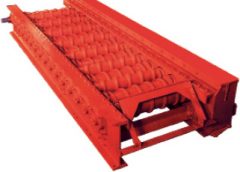McLanahan’s Universal Wobbler Feeder provides two functions:
|
|
| Wobbler Feeder. |
 |
| Ultra Fine Recovery System. |
- Feeding oversized material at a controlled rate.
- Scalping out the fines from feed material.
This is accomplished by football-shaped elliptical bars, timed with a continuous triple strand roller chain drive and timed bar sprockets to tumble and move the loaded material along the bars until it is discharged off the feeder.
Each bar maintains a constant gap allowing the fines to pass through the bar gaps and discharge the undersized scalped material below. Each elliptical bar is timed 90 degrees apart, with one bar tip up and the next bar rotated with the tip in a horizontal position.
All bars rotate at the same rate of speed. Wobbler Feeders are self-cleaning, can handle wet, sticky material and are very good with clay.
McLanahan manufactures four Wobbler Feeder models, each with different standard widths and number of bar combinations. Each Wobbler is custom designed to meet a wide range of tonnage and application requirements. Designed to scalp material from ½- to 7-½-in. lump size and tonnage up to 2,500 tph.
McLanahan’s portable Ultra Fine Recovery System (UFR) is ideal for producers wishing to move the system to a different spot in the site, or a new site in general.
The UFR itself helps producers by extracting as many fines as possible from water before sending it to a pond or further processing. It provides a cost effective way to recover nominally +400 mesh (38 micron) fines as a conveyable, stackable product for industries including sand, coal recovery, ash, industrial sands, frac sand and more.
Field-proven equipment, including a dewatering screen, sump, pump and small diameter cyclones/separators, make up McLanahan’s Portable UFR. They provide the finest size fraction recovery available without the use of chemicals.
This saves producers money when dealing with ponds by sending less tons per hour of fines into the pond every day. It is also an ideal system for producers who face strict permitting requirements and have limited land resources.
McLanahan, www.mclanahan.com

